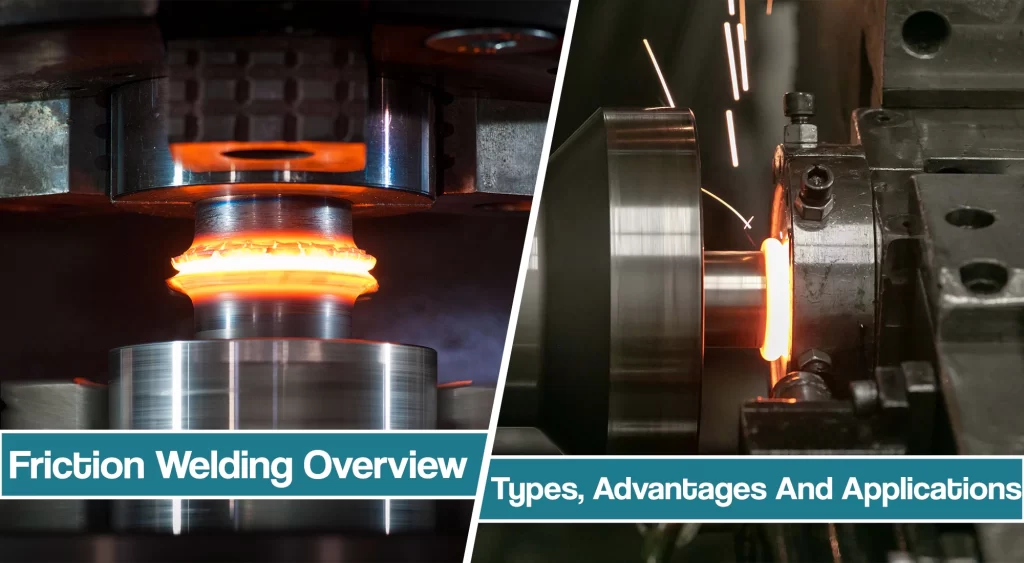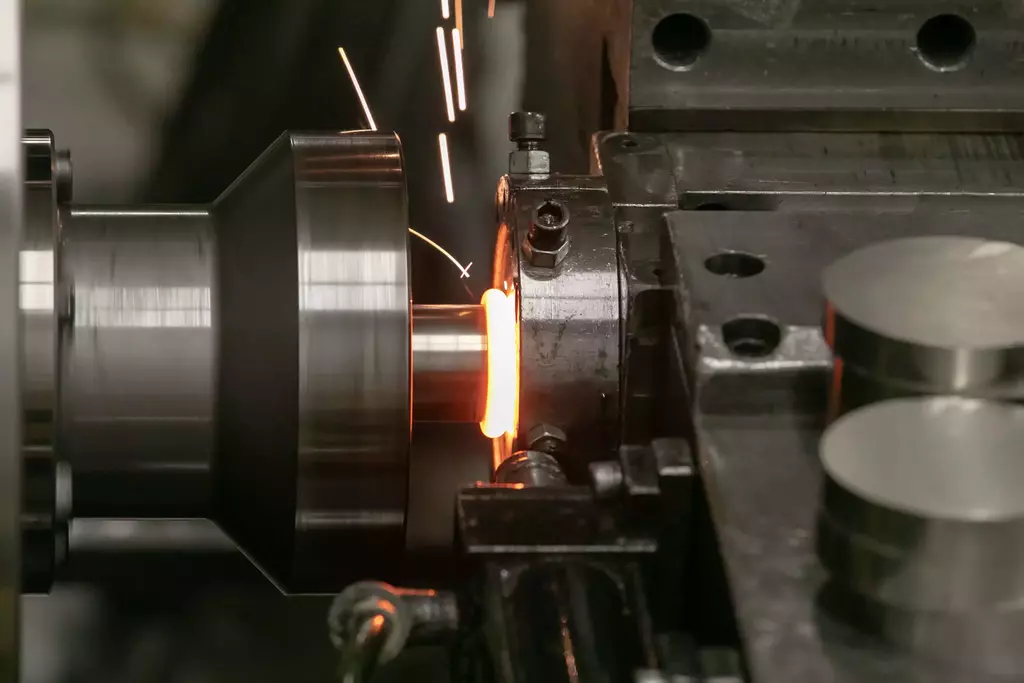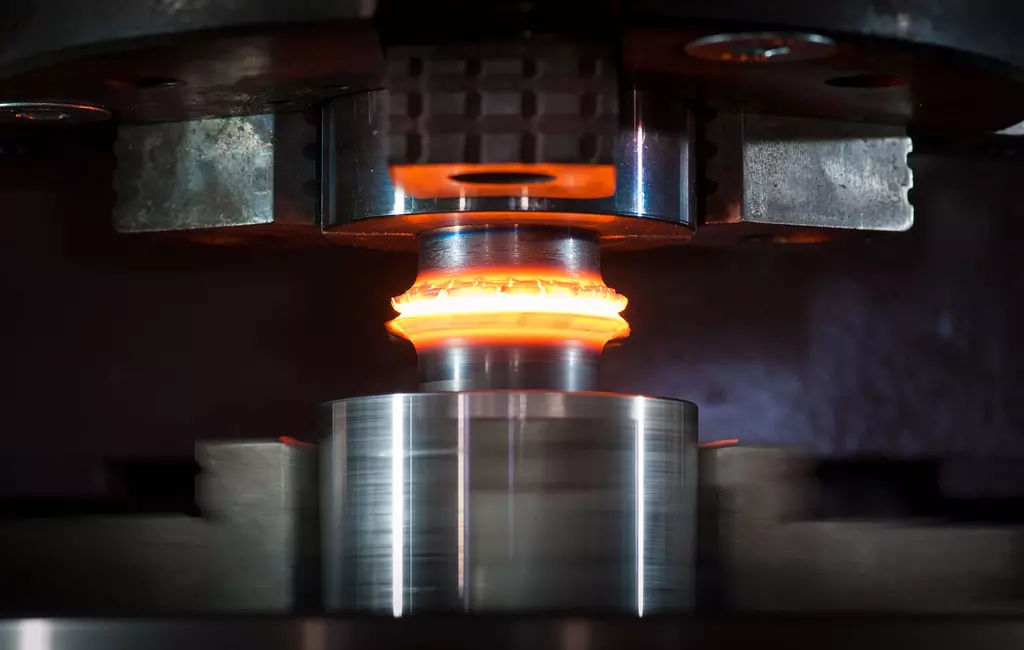Friction welding is a solid-state welding process that joins workpiece material using heat generated through rotary friction. Today, we recognize friction stir welding (FSW), friction stir spot welding (FSSW), rotary friction welding (RFW), and linear friction welding (LFW).
In this article, you’ll learn what friction welding is, how it works, its advantages, and its applications.

What is Friction Welding
Friction welding is actually a category of welding processes that consists of four main friction welding processes: friction stir welding (FSW), friction stir spot welding (FSSW), rotary friction welding (RFW), and linear friction welding (LFW).
- Friction stir welding uses a dedicated rotary tool that glides along the joint line between two metals. The rotation causes friction, and the two metals are joined. The non consumable tool rotates at speed necessary to soften and join the base metal. However, the rotary tool is made of a more durable material, not affected by friction.
- Friction stir spot welding works by the same principle as the FSW described above. But, instead of making linear welds, it joins metal with spot welds.
- Linear friction welding linearly oscillates one workpiece material in relative motion to another while applying a compressive force. The friction between the oscillating surfaces produces heat. As a result, the material at the contact surfaces softens and mechanically mixes.
- The rotary friction welding process is similar to the linear friction welding described above. But, instead of linear agitation, the rotary friction welding process rotates the workpiece relative to each other.
The rotary and linear friction welding processes shorten the workpieces in the direction of the compressive force. As the contact surfaces “burn-off” the contaminants from the joint are expelled in a flash. So, oxides and other contamination are pushed outside, resulting in a clean, integral bond.
How Friction Welding Process Works
Friction welding involves rotating or linear friction welding to create the heat necessary to soften and fuse two metal parts. It’s used to fuse two smooth, clean surfaces. Friction welding processes are not used to weld uneven, jagged, or overly rough surfaces.
However, an apparently smooth surface actually has a significant number of tiny projections called asperities.

While these projections can’t be seen with a bare eye, they are large enough to cause friction when two such surfaces glide one over another. Their asperities make contact, and friction heats the parent material.
The induced mechanical motion results in elastic and plastic yielding of asperities, causing heat, which makes metal soft and viscous. Thanks to mechanical friction and applied pressure, the softened material mixes from one metal part to another. But, the specifics of how the metal is mixed depend on the particular friction welding process we previously discussed.
Advantages of Friction Welding
Friction welding has numerous benefits to conventional welding like arc welding processes. Since it’s a fast, solid state welding process, the welded joints are uniform, with maximum penetration and excellent price-to-joint ratio.
But, let’s take a look at the advantages of this manufacturing process in more detail.
No flux or external heat – Friction welding can produce welds without any external heat. This minimizes the required energy to join metal. The heat obtained from the rotating workpiece and friction phase is adequate to join metal — no extra energy is wasted. Additionally, flux use is not required. The process is clean and leaves no mess to clean up.
Joins dissimilar metals – One of the most significant advantages of friction welding is that it can join different metals. Not many welding methods can weld dissimilar materials. So, a friction welding machine is often necessary in large volume manufacturing where joining dissimilar material is paramount.
There is no need for a shielding gas – Since welded metal never reaches a molten phase and impurities are pushed out during the mixing phase, this joining process doesn’t require shielding gases to protect the weld pool.
Frictional heat is low – Friction welding applies significantly lower heat than fusion welding. Low heat generation reduces the negative impact of heat affected zone and intermetallic formation. Material properties are usually not impaired, allowing a strong joint without the need for post welding heat treatment.
Solid state welding process – This joining technique avoids defects associated with fusion welding like pores and solidification cracks. The butt welding joints never reach melting temperatures because this is a solid state process — metal remains in a solid form.
No filler metal required -Since friction welding joins two welded metals by rubbing surfaces and mixing their softened materials, this inertia welding process doesn’t need a filler metal. As a result, costs are reduced, and the process is simplified.
Friction Welding Applications
The friction welding process is especially useful for serial, high-volume production.
This manufacturing technology drastically reduces labor costs and allows easy automation of the welding cycle. It is applied to weld big and small parts.
The machining and part industry benefits significantly from friction welding. Parts like piston heads, cylinders, shafts, crankshafts, drill bits, cogwheels, and valves are friction welded.

In the aviation industry, parts like spindles, turbines, pipes, fittings, rotors, and combustion chambers utilize the friction welding metal joining process.
And last but not least, the automotive industry applies friction welding to weld drive shafts, gear leavers, break spindles, transmission mechanisms, pipe spindles, valves, and preheat rooms.
Friction welding is applied in various other industries. If the metal pieces are joined in high-volume production, the chances are that friction welding is employed.
Conclusion
Friction welding is a solid-state joining process that’s universally used, unlike many other solid-state welding methods. For example, the cold welding process is not as widely applied.
To achieve high weld quality quickly and at a low cost, the friction welding joining technique is one of the most applied. However, it still cannot match the versatility and application of arc welding processes. But, the arc welding processes cannot match the speed and joint quality produced by friction welding.
Whenever possible, it’s preferable to apply friction welding in part production. But, this is a very specialized process that makes sense to use only if you can apply the rotary friction welding method. It’s not possible to weld parts with different shapes if the joint face is not smooth.





